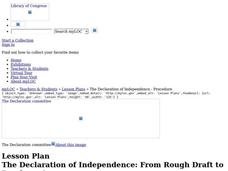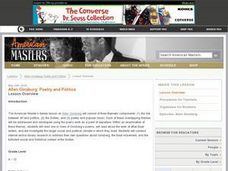National Endowment for the Humanities
The Argument of the Declaration of Independence
When in the course of a course on historic American events, it becomes necessary for learners to examine, with decent respect, the Declaration of Independence, it becomes evident that there are six separate and equal parts of that...
Curated OER
Boogie Woogie with a B: Using Alliteration while Exploring Patriotic Tunes
Are you looking for a way to bring writing into your history instructional activity - or history into your writing instructional activity? This cross-curricular activity is helpful and fun, no matter what class you're teaching! Using...
Curated OER
The Bill of Rights: Debating the Amendments
Provide your class with an opportunity to investigate an important historical document. Without identifying the document, distribute copies of the original Bill of Rights, as transcribed by John Beckley, Clerk of the House of...
Curated OER
The Declaration of Independence: From Rough Draft to Proclamation
Students discover how the Declaration of Independence transformed from a draft to a treasured historical document. In this Declaration of Independence lesson, students discuss the context in which Jefferson wrote the document and analyze...
Curated OER
How To Do an AHAP DBQ
How is an essay like a hamburger? Detailing the "meaty" parts of a well-written essay, this presentation takes students through the process of using a strong thesis statement to write a thorough and engaging response to a Document Based...
Curated OER
Worksheet for Analysis of a Letter
Dear Nancy, how do you analyze a letter? Love, Trez. Dear Trez, you use a Letter Analysis Worksheet. Love, Nancy.
This richly detailed worksheet provides multiple questions that lead researchers step-by-step through the process of...
Curated OER
Family Stories and Personal Narratives
Fourth graders read various stories in their literature books about families. Individually, they make a timeline showing the most important events in their lives. They bring in one artifact from their lives and write a paper about it...
Curated OER
Combing Through the News
Students use the Sean 'Puffy' Combs trial to compare how and why various media cover a news story differently.
Curated OER
Activating Students
Students view and analyze one example of student activism in the 1960's and then apply their learning to their own situations. They work cooperatively to develop and implement their own "activist" or community service learning plan.
Curated OER
The Shakespeare Crowd
Learners study the life and times of Shakespeare. They read and analyze one of his plays and use the Internet and videos to gain an understanding of how Shakespeare engaged his audiences, then and still today.
Curated OER
Allen Ginsberg: Poetry and Politics
Students explore the poetry of Allen Ginsberg. They read and analyze poems by Allen Ginsberg, conduct Internet research, collect examples of art of the 60s, and create a presentation.
Curated OER
Thomas Jefferson's Library: Making the Case for a National Library
Students examine the need for a national library. In this Library of Congress lesson, students analyze primary sources to investigate the persuasive techniques that Thomas Jefferson used in a letter meant to show his...
Curated OER
Holocaust Memorial Service
Young scholars research victims of the Holocaust, then create pieces of art to depict the suffering of the Holocaust victims.
Curated OER
Renaissance Realities
Students analyze passages by Niccolo Machiavelli and Francis Bacon as an analysis of Renaissance ideas in contemporary situations. For this Renaissance writings lesson, students read excerpts from Machiavelli's The Prince and multiple...
Curated OER
Voices of Tragedy and Horror: Remembering the Holocaust
Students consider the implications of the Holocaust. In this World War II lesson, students read the graphic novel Maus at the end of a unit on World War II. Students discuss the impact of reading about the Holocaust as well as theme of...














